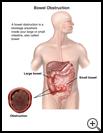
Bowel Obstruction: Large Bowel
________________________________________________________________________
KEY POINTS
- A large bowel obstruction is a blockage anywhere inside your large intestine. A blockage may stop all food, gas, or fluids from passing through or just make it harder to pass through and out of your body.
- Treatment may include enemas, changes in your diet, or surgery to remove the cause of the blockage. You may need a colostomy to make an opening in your belly and bring the end of the intestine to the outside. Bowel movements will then leave your body through this new opening.
- It may help if you exercise daily, eat a diet high in fiber, and drink plenty of water.
- If you have a health problem that caused the blockage, be sure you know what to do to manage that health problem and help keep from having another blockage.
________________________________________________________________________
What is a large bowel obstruction?
A large bowel obstruction is a blockage anywhere inside your large intestine. The large bowel (also called the colon) is the last 5 feet of your intestines. The rectum is the last few inches of the large bowel. The rectum connects with the anus, where your bowel movements come out. A blockage may stop all food, gas, or fluids from passing through or just make it harder to pass through and out of your body.
If a blockage is not treated, it can become a life-threatening medical emergency.
What is the cause?
Common causes of a blockage are:
- Tumors or scar tissue that block the intestine
- Diverticulitis, which is swelling and irritation of pouches in the lining of the intestines that may get infected
- A twisting of the intestines
- A hard lump of bowel movement that gets stuck
- Hernia, which is when part of the intestine bulges through a weak area or gap in the muscles in the wall of the belly. The hernia can twist or narrow and block passage of stool.
What are the symptoms?
The first signs of a blockage may be a change in bowel habits, such as little or no gas, or no bowel movements. Other symptoms may include:
- Cramping, swelling, and pain in your belly that comes and goes and becomes more severe
- Nausea or vomiting
If your intestine is only partly blocked, you may have diarrhea.
How is it diagnosed?
Your healthcare provider will ask about your symptoms and medical history and examine you. Tests may include:
- Rectal exam, which your provider does by gently putting a lubricated and gloved finger in your rectum. Your provider may also place his or her other hand on your belly to feel and check the size and shape of your organs.
- X-rays of the belly
- CT scan, which uses X-rays to show detailed pictures of your intestines
- Colonoscopy, which uses a flexible, lighted tube, put through your rectum to look at the inside of your colon. A similar test called a sigmoidoscopy looks at just the lower one-third of your colon.
- Blood tests
- Urine test
- Test of bowel movements for blood
How is it treated?
Treatment depends on what is causing the blockage.
If the blockage is from a hard lump of bowel movement near the anus, your provider may be able to remove it with enemas or by putting a gloved, lubricated finger into your rectum. Your provider may recommend some changes in your diet to prevent future problems.
You may need to be treated in the hospital with an IV to give you fluids and medicines. You may also have a tube put through your nose and into your stomach to help drain fluid and gas. Sometimes a tube is put into your rectum to help relieve gas and make you more comfortable.
You may need to have surgery to remove the cause of the blockage. This is more common with complete blockages. A complete blockage is a medical emergency. Part of your intestine may also need to be removed.
You may need a colostomy. This means that your healthcare provider will make an opening in your belly and bring the end of the intestine to the outside. Bowel movements will then leave your body through this new opening. It will be collected in a disposable bag. In most cases the colostomy is temporary. This means that you will have a second surgery to rejoin the ends of intestine to each other, and no longer have an opening in the wall of your belly.
How can I take care of myself?
Follow the full course of treatment prescribed by your healthcare provider. Ask your provider:
- How and when you will get your test results
- How long it will take to recover
- If there are activities you should avoid and when you can return to your normal activities
- How to take care of yourself at home
- What symptoms or problems you should watch for and what to do if you have them
Make sure you know when you should come back for a checkup. Keep all appointments for provider visits or tests.
How can I help prevent a large bowel obstruction?
Exercise daily and eat a diet high in fiber and low in fat and cholesterol. If you are not used to high-fiber diets, start slowly. Drinking plenty of water helps your intestines to work normally.
If you see blood in a bowel movement or have a change in bowel habits, tell your healthcare provider.
If you have a health problem that caused the blockage, be sure you know what to do to manage that health problem and help keep you from having another blockage.
If you are 50 or older, ask your healthcare provider how often you should have colorectal cancer screening. If you are an African-American, your healthcare provider may recommend a screening colonoscopy at age 45.

